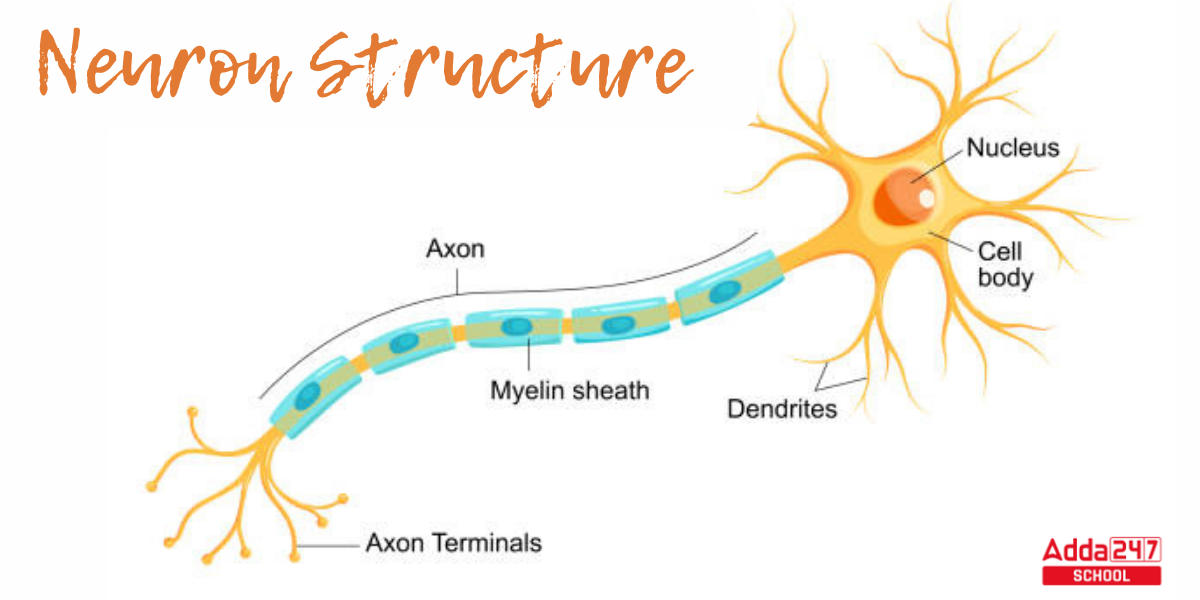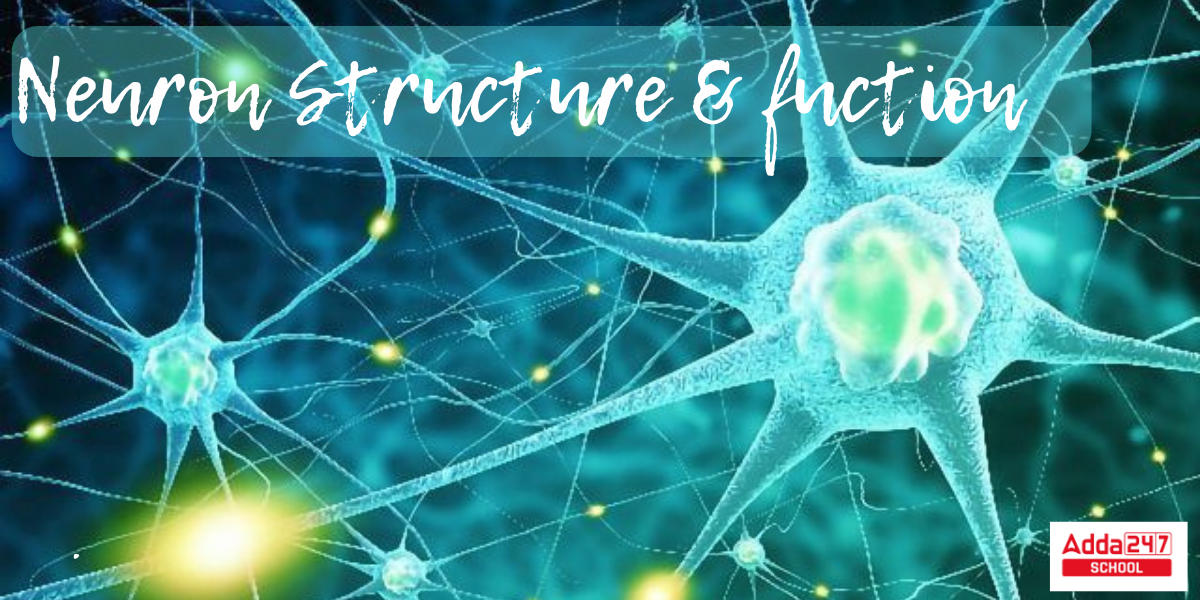Neuron: Neurons, also known as nerve cells, are the basic building blocks of the neurological system. Neurons receive and transfer impulses to many sections of the body in both physical and electrical ways. Neurons, or nerve cells, are responsible for absorbing sensory input from the outside world, transmitting motor instructions to our muscles, and converting and relaying electrical impulses at every step in the process. A neuron is made up of three major components: dendrites, an axon, and a cell body or soma. Read the entire article to learn about Neuron Structure, 3 Types of Neurons and Functions, and more.
What is a Neuron?
Consider a neuron structure to be a Banyan tree. Neuron dendrites and axons can be compared to the branches, roots, and trunk of a mature tree, respectively. A neuron gets input from neighboring cells via a dendrite or tree branch. Dendrites, like tree branches, branch as they grow toward their tips, and they even have leaf-like projections called spines on them. The axon, or tree roots, is the neuron’s outflow structure; when one neuron wishes to communicate with another, it sends an electrical signal called an action potential across the entire axon. The soma, or tree trunk, contains the nucleus, the neuron’s genetic material, and the proteins that are delivered across the axon and dendrites.
Neuron Diagram
The size, design, and structure of neurons vary based on their function and location. Almost all neurons, however, have three basic components: a cell body, an axon, and dendrites. Examine the Neuron Diagram below to learn about the cell body, axon, dendrites, and overall structure of the Neuron.

Neuron Cell
The nerve cell /neuron cell is the primary unit of communication in the neurological / Nervous system. The cell body, which consists of the nucleus, a large branching fiber that is the axon, and multiple smaller branching fibers that are dendrites comprise each nerve cell. The myelin sheath is a fatty substance that coats, insulates, and protects brain and spinal cord nerves. Neurogenesis is a process of the formation of new neurons/ nerve cells in the brain. Neurons of various sorts exist in both the brain and the spinal cord. They are classified based on where they originate, where they project to, and which neurotransmitters they employ.
Neuron Structure
The form and size of a neuron structure vary based on its function and location. Dendrites, cell bodies, and axons are the three distinct components of all neurons. all these components of Neuron Anatomy are discussed below.
Axon
Neurons typically have a single major axon.
- The axon is a tube-like arrangement that transports electrical impulses from the cell body to axon terminals, which then transmit the impulse to the next neuron.
- It connects to the cell body via a specialized junction known as the axon hillock.
- Myelin, a fatty material, is used to insulate many axons. Myelin aids axons in the transmission of electrical signals.
Dendrites
Neurons can have many sets of dendrites, which are referred to as dendritic trees.
- These resemble branches or dendrites and are responsible for receiving signals from other neurons and relaying them to the cell body.
- Dendrites are roots of fibrous tissue that extend from the cell body.
- Purkinje cells, for example, dendritic trees, are a type of neuron located in the cerebellar region of the brain. These cells’ dendritic trees are highly developed, allowing them to receive millions of impulses.
Cell Body
The cell body, frequently referred to as a soma, is the central part of the neuron.
- Each neuron has a cell body that includes a nucleus, Golgi apparatus, endoplasmic reticulum, mitochondria, and other components.
- It is surrounded by a membrane that protects it while also allowing it to interact with its surroundings.
- The cell body stores genetic information, preserves the structure of the neuron, and provides energy to power operations.
Neuron Synapse
Synapses are tiny voids that connect one neuron’s terminal buttons to receptors (typically situated on the dendrites) of another neuron.
- When neurons interact, chemicals are released that must traverse this gap to stimulate post-synaptic receptors.
- There are trillions of neurons in the human brain. Thus, each neuron interacts over tens of synapses on average, while the range is very broad – some neurons terminate in a few synapses, while others may communicate through thousands of synapses.
- Neurons communicate with other cells as well. For example, neurons that govern the motor system connect and synapse with muscle cells.
Types of Neuron
Neurons are the essential units that send and receive impulses that allow us to move our muscles and sense our surroundings.
3 Types of Neurons and Functions
Neurons are classified into three types – Sensory neurons, Motor Neurons, and Interneurons.
Sensory Neuron
Sensory neurons translate inputs from the external world into internal stimuli. The majority of sensory neurons are pseudounipolar, implying they only have one axon divided into two branches.
Function – Sensory inputs activate sensory neurons, which then transmit sensory information to the brain and spinal cord. When you touch a heated surface with your fingertips, for example, sensory neurons will fire and convey messages to the rest of the nervous system about the information they acquired.
Motor Neurons
These are multipolar neurons and are found in the central nervous system, with axons spreading outside of the central nervous system. The spinal cord’s motor neurons constitute a component of the central nervous system (CNS) and link to muscles, glands, and organs throughout the body.
Motor neurons are classified into two types: those that flow from the spinal cord to muscle and those that travel between the brain and the spinal cord.
Function – These neurons control all of our muscular movements by transmitting impulses via the spinal cord to skeletal and smooth muscles, including those in the stomach.
Interneurons
Interneurons are like motor neurons and have a multipolar configuration. Their axons only communicate with adjacent sensory and motor neurons.
Function – They aid in the transmission of signals between two neurons. Interneurons can communicate with one another as well as convey signals between sensory and motor neurons, forming circuits of different levels of difficulty.
Function of Neuron in points
Neurons use action potentials to deliver signals. Whenever an action potential is produced, it travels through the axon to a presynaptic terminal. Synapses are sites where neurons can exchange electrical and chemical signals. Both chemical and electrical synapses can be triggered by action potentials. A presynaptic terminal, a synaptic cleft, and a postsynaptic ending comprise a synapse. The function of neuron in points are explored further below.
1. Chemical Synapses
The neuron emits chemical messengers known as neurotransmitters at a chemical synapse. These neurotransmitters stimulate postsynaptic neurons, which create their own action potentials. These chemicals traverse the synaptic cleft and attach to receptors in the dendrite’s postsynaptic end. They can also inhibit action in the postsynaptic neuron. The postsynaptic neuron is unable to produce an action potential in this circumstance.
2. Electrical synapses
Only electrical synapses may stimulate. When two nerve cells are joined by a gap junction, these synapses occur. Ion channels, which aid in the direct transmission of a positive electrical signal, are among the gaps. Electrical synapses move signals considerably faster than chemical synapses because of the way they travel. These impulses, however, can fade from one neuron to the next. As a result, they are less successful at transmitting recurrent signals.









 Madras University Result 2025 OUT at uno...
Madras University Result 2025 OUT at uno...
 CUET Geography Important Topics 2026 | B...
CUET Geography Important Topics 2026 | B...
 BCECE LE 2025 Counselling Dates Out, Che...
BCECE LE 2025 Counselling Dates Out, Che...









